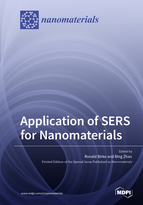Application of SERS for Nanomaterials
A special issue of Nanomaterials (ISSN 2079-4991). This special issue belongs to the section "Nanoelectronics, Nanosensors and Devices".
Deadline for manuscript submissions: closed (1 October 2021) | Viewed by 26174
Special Issue Editors
Interests: electrochemistry; Raman spectroscopy; theoretical chemistry
Interests: Vibrational spectroscopy; Spectroscopic analysis; Surface-enhanced Raman scattering (SERS) spectroscopy; The novel SERS substrates of semiconductive nanoparticles; SERS bio- and envorinmental analysis techniques
Special Issue Information
Dear Colleagues,
Since its discovery over forty-five years ago, SERS has blossomed into an exciting field of study that spans major fields of science, including analytical and physical chemistry, solid-state physics and optics, biosciences, medical diagnostics, and sensor engineering. In this Special Issue, we welcome new developments in SERS. One of the most important areas of research involves the development of novel substrates, such as arrays of metallic nanoparticles (NP), semiconductor quantum dots, composite core-shell NP substrates, soft systems such as organic semiconductors and J-aggregates, fabricated hot-spots in nanometer-sized gaps, electrochemical etched SERS substrates, and wire substrates for tip-enhanced Raman scattering (TERS). Many of these substrates allow single-molecule (SM) detection, which is a fascinating area of SERS research. Papers dealing with measuring and understanding the enhancement factor (EF) and the mechanism of enhancement of chemical systems adsorbed on these substrates are of interest for this issue. The main factors in the Raman enhancement are the EM effect of the substrate on the incident light involving plasmon resonances and the chemical mechanism involving charge transfer (CT) resonances between the substrate and molecule and possible molecular resonances. Theoretical treatments of the enhancement mechanisms by computational chemistry and physics using DFT (TDDFT) and periodic plane-wave methods are also of interest. Finally, papers dealing with the nature of chemical systems on SERS substrates, such as surface geometry, the identification of molecules of topical interest, such as drugs and biomolecules, and the study of chemical reactions on surfaces are welcome. Articles dealing with future trends and challenges involving either experimental or theoretical methods would be especially appreciated.
Prof. Dr. Ronald Birke
Prof. Dr. Bing Zhao
Guest Editors
Manuscript Submission Information
Manuscripts should be submitted online at www.mdpi.com by registering and logging in to this website. Once you are registered, click here to go to the submission form. Manuscripts can be submitted until the deadline. All submissions that pass pre-check are peer-reviewed. Accepted papers will be published continuously in the journal (as soon as accepted) and will be listed together on the special issue website. Research articles, review articles as well as short communications are invited. For planned papers, a title and short abstract (about 100 words) can be sent to the Editorial Office for announcement on this website.
Submitted manuscripts should not have been published previously, nor be under consideration for publication elsewhere (except conference proceedings papers). All manuscripts are thoroughly refereed through a single-blind peer-review process. A guide for authors and other relevant information for submission of manuscripts is available on the Instructions for Authors page. Nanomaterials is an international peer-reviewed open access semimonthly journal published by MDPI.
Please visit the Instructions for Authors page before submitting a manuscript. The Article Processing Charge (APC) for publication in this open access journal is 2900 CHF (Swiss Francs). Submitted papers should be well formatted and use good English. Authors may use MDPI's English editing service prior to publication or during author revisions.
Keywords
- surface-enhanced Raman scattering
- surface plasmon resonance
- charge transfer resonance
- time-dependent Raman theory
- biological and chemical Raman sensing
- hot-spots
- tip-enhanced Raman scattering







